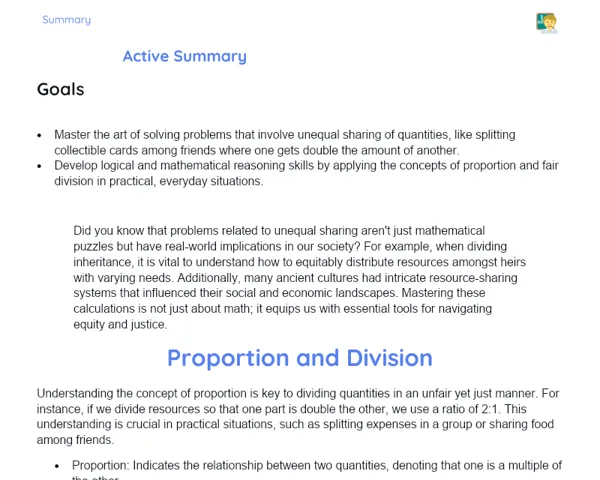Summary Tradisional | Fractions: Common Denominators
Contextualization
Fractions are a basic way of showing parts of a whole. Think of dividing a pizza into eight slices – if you eat three slices, you are essentially using the fraction 3/8 to represent the part you consumed. This simple idea finds its place in many areas of our daily life, whether it be in cooking, music, or even in professions that demand precision, such as engineering and carpentry.
It is important to note, however, that not all fractions can be directly compared or combined. When adding or subtracting fractions, they must share the same denominator – the common basis for comparison. If the fractions have different denominators, we must first convert them into a common one using equivalent fractions – different fractions that represent the same quantity. Grasping how to find common denominators is key to solving more intricate mathematical problems and applying these concepts practically in everyday situations.
To Remember!
Common Denominators
Having a common denominator is vital when performing addition or subtraction with fractions. Essentially, the common denominator is a multiple that is shared by the denominators of two or more fractions. In simple terms, when the fractions have the same denominator, comparing or combining them becomes straightforward since they refer to parts of a whole partitioned in a similar manner.
To determine a common denominator, we use the concept of the Least Common Multiple (LCM) – the smallest number that can be a multiple of the denominators involved. For instance, with fractions 1/4 and 3/8, the LCM of 4 and 8 is 8. This allows us to convert 1/4 into 2/8 so that both fractions share the same denominator.
Mastering the use of common denominators is a fundamental skill that helps students add and subtract fractions accurately and efficiently. Without this understanding, it would be challenging to combine fractions correctly, which is especially important when tackling more advanced problems in mathematics.
-
Common denominators are needed for adding or subtracting fractions.
-
The Least Common Multiple (LCM) helps in finding common denominators.
-
They enable us to compare and combine fractions effectively.
Fractions with Different Denominators
Fractions that have different denominators can’t be directly added or subtracted because they break the whole into unequal parts. For example, 1/3 and 1/4 split a whole into 3 and 4 parts respectively. To add or subtract such fractions, we must first convert them into fractions with a common denominator.
The initial step is to identify that the fractions have different denominators, and then find the LCM of these denominators. As an example, the LCM of 3 and 4 is 12, so 1/3 becomes 4/12 and 1/4 turns into 3/12.
This is achieved by multiplying both the numerator and the denominator of the fraction by the same number, thereby keeping the value unchanged. This method is basic yet essential for solving fraction problems effectively, and it is a skill that every student should learn well.
-
Fractions with different denominators cannot be added or subtracted directly.
-
The first step is to recognise the need for conversion by identifying different denominators.
-
Finding the LCM allows the fractions to be rewritten with a common denominator.
Equivalent Fractions
Equivalent fractions are those that, although having different numerators and denominators, represent the same part of a whole. A classic example is 1/2, which is equivalent to 2/4 as both indicate half of the total. This is achieved by multiplying or dividing the numerator and the denominator by the same number without changing the fraction’s value.
When we need to work with fractions that initially have different denominators, we use equivalent fractions to convert them. For example, to combine 1/3 and 1/6, we notice that the LCM of 3 and 6 is 6. Since 1/6 already has 6 as the denominator, we can convert 1/3 into 2/6 by multiplying both numbers by 2.
A solid understanding of equivalent fractions is crucial for effectively managing and manipulating fractions in various operations. Without this, students might struggle with more complex mathematical tasks such as addition, subtraction, multiplication, and division involving fractions.
-
Equivalent fractions, though appearing different, represent the same value.
-
Multiplying or dividing both the numerator and denominator by the same number keeps the fraction’s value unchanged.
-
They are essential for converting fractions to a common denominator.
Applying Common Denominators in Problems
Using common denominators in mathematical problems is a core aspect of learning fractions. When students face problems involving the addition or subtraction of fractions with different denominators, they must first convert these decimals into fractions with a common denominator in order to reach the correct solution.
Take for instance the problem 2/5 + 3/10. Students must first determine that the LCM of 5 and 10 is 10. They then convert 2/5 to 4/10, and finally add it to 3/10, resulting in 7/10. This practical approach not only underlines the importance of common denominators but also lays the groundwork for understanding more advanced mathematical topics.
Being comfortable with this conversion process is crucial, as it forms the basis for future studies in subjects such as algebra and calculus. Regular practice of this skill helps build confidence in handling complex mathematical scenarios.
-
Common denominators play a critical role in solving problems involving fractions.
-
Converting fractions to a common denominator is a vital step in adding or subtracting them.
-
The skill is foundational for grasping advanced mathematical concepts.
Key Terms
-
Common Denominators: These are common multiples of the denominators of two or more fractions, and are necessary for carrying out operations with fractions.
-
Least Common Multiple (LCM): The smallest number that is a common multiple of two or more numbers, used to determine common denominators.
-
Equivalent Fractions: Different fractions that represent the same value or part of a whole.
-
Fraction Conversion: The process of turning fractions with different denominators into fractions that share a common denominator.
-
Addition and Subtraction of Fractions: Operations that require fractions to have the same denominator to be performed correctly.
Important Conclusions
In this lesson, we took a closer look at fractions and the significance of common denominators when it comes to adding and subtracting fractions. We saw that fractions with dissimilar denominators need to be converted using equivalent fractions to bring them to a common ground. This technique is essential not only for solving math problems correctly but also for preparing students for more challenging topics ahead.
We learnt that the Least Common Multiple (LCM) is a very useful tool in finding a common denominator, enabling us to convert fractions efficiently. The application of these principles extends beyond the classroom, whether you are measuring ingredients for a recipe or calculating dimensions in an engineering project. With regular practice, mastering these concepts becomes second nature.
The session also emphasised understanding equivalent fractions – a key step in converting fractions without losing their inherent value. This foundational knowledge is vital for progressing in mathematics, and we encourage students to keep practising these techniques to build further confidence and expertise.
Study Tips
-
Practice converting fractions with different denominators to a common denominator using the Least Common Multiple (LCM).
-
Try solving real-life problems involving fractions, such as splitting a bill or dividing ingredients in a recipe, to reinforce your understanding.
-
Review equivalent fractions regularly by creating your own examples, which helps in understanding how multiplying or dividing maintains the fraction's value.



